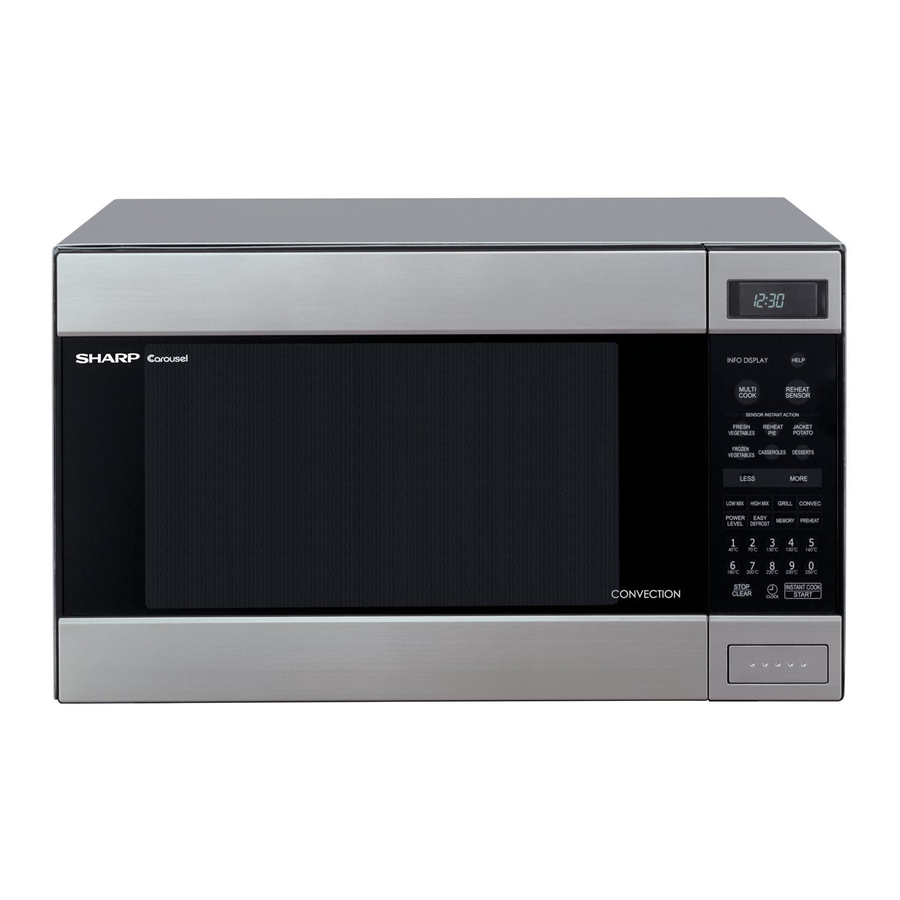Sharp Carousel R-990K 서비스 매뉴얼 - 페이지 8
{카테고리_이름} Sharp Carousel R-990K에 대한 서비스 매뉴얼을 온라인으로 검색하거나 PDF를 다운로드하세요. Sharp Carousel R-990K 48 페이지. Convection microwave oven
Sharp Carousel R-990K에 대해서도 마찬가지입니다: 운영 매뉴얼 (41 페이지)

R990K(W)
2) The oven will continue to function for 30 minutes, turning the
convection heater on and off, as needed to maintain the
selected preheat temperature. The oven will shut-down com-
pletely after 30 minutes.
2. CONVECTION COOKING CONDITION
When the preheat temperature is reached, a beep signal will sound
indicating that the holding temperature has been reached in the oven
cavity. Open the door and place the food to be cooked in the oven.
Press the CONVEC-TION pad and then enter the cooking temperature
by pressing the temperature pad. And then enter the cooking time by
pressing the NUMBER pads. When the START pad is touched, the fol-
lowing operations occur:
1. The numbers of the digital read-out start the countdown to zero.
2. The oven lamp, turntable motor, cooling fan motor and convection
motor are energized.
3. Heater relay (RY3) is energized (if the cavity temperature is lower
than the selected temperature) and the main supply voltage is
applied to the convection heater to return to the selected cooking
temperature.
4. Upon completion of the cooking time, the audible signal will sound,
and oven lamp, turntable motor, cooling fan motor and convection
motor are de-energized. At the end of the convection cycle, if the
cavity air temperature is above 116°C, the circuit to(RY6) will be
maintained (by the thermistor circuit) to continue operation of the
cooling fan motor until the temperature drops below 116°C, at
which time the relay will be de-energized, turning off the fan
motor.Relay (RY5) will however, open as soon as the convection
cycle has ended, turning off the convection fan motor. This will now
cool and allow the damper door to open.
5. At the end of the convection cook cycle, shut-off relay(RY4) is ener-
gized turning on the damper motor. The damper is returned to the
open position, closing the damper switch contacts which send a
signal to the control unit, de-energizing shut-off relay (RY4).
[4] AUTOMATIC MIX COOKING CONDITION
Choose the LOW MIX or HIGH MIX by pressing the LOWMIX pad or
HIGH MIX pad. And then enter cooking time by pressing the NUMBER
pads. When the START pad is touched, the following operations occur:
1. The numbers of the digital read-out start the countdown to zero.
2. The shut-off relay (RY1+RY5+RY6) energized, turning on the oven
lamp, turntable motor, cooling fan motor and convection motor.
3. The shut-off relay (RY4) is energized.
The damper door is closed from the open position.
4. The heater relay (RY3) is energized, adding the mains supply volt-
age to the convection heater.
5. Now, the oven is in the convection cooking condition.
6. When the oven temperature reaches the selected temperature, the
following operations occur:
1) The power supply voltage is added to the convection heater and
power transformer alternately.
2) The convection heater operates through the heater relay (RY3)
contacts and the power transformer operates through the cook
relay (RY2) contacts.
3) These are operated by the CPU unit to supply alternately within
a 48 second time base, convection heat and microwave energy.
The relationship between the convection and microwave power opera-
tions are as follows.
NOTE: The ON and OFF time ratio does not correspond with the per-
centage of microwave power, because approx. 2 seconds are
needed for heating of the magnetron filament.
8 S E C .
ON
(MIC R O.)
OF F
(C ONV E C .)
16 S E C .
ON
(MIC R O.)
(C ONV E C .)
OF F
NOTE: During alternate Microwave/Convection operation, the con-
vection heater is energized only if the cavity temperature
drops below the set temperature.
[5]
ABSOLUTEHUMIDITYSENSOR
SENSOR)COOKING CONDITION
n case where the AH sensor is used (REHEAT SENSOR or SENSOR
INSTANT ACTION), the foods are cooked in microwave cooking mode
without figuring time, power level or quantity. When the oven senses
enough steam from the food, it relays the information to its micropro-
cessor which will calculate the remaining cooking time and power level
needed for best results. When the food is cooked, water vapour is
developed. The sensor "senses" the vapour and its resistance
increases gradually. When the resistance reaches the value set
according to the menu, supplementary cooking is started. The time of
supplementary cooking is determined by experiment with each food
category and inputted into the LSI.An example of how sensor works:
1. Potatoes at room temperature. Vapour is emitted very slowly.
2. Heat potatoes. Moisture and humidity is emitted rapidly.You can
smell the aroma as it cooks.;
5 – 2
40 S E C .
MIC R OWAV E P OWE R
= AP P R OX. 10%
C ONV E C T ION
T E MP E R AT UR E
LOW MIX
32 S E C .
MIC R OWAV E P OWE R
OF F
= AP P R OX. 30%
ON
C ONV E C T ION
T E MP E R AT UR E
48 S E C .
HIG H MIX
= 180û C
= 200û C
(AH
